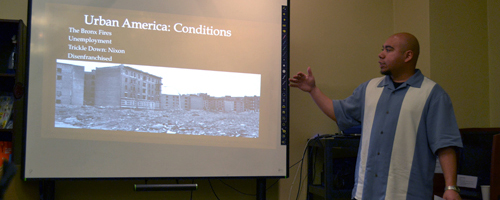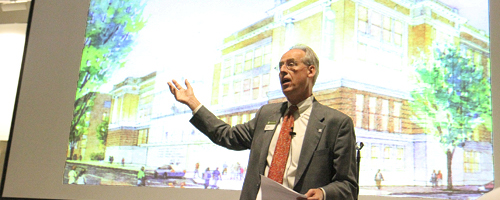For the first time, in December, Portland State sent a group of 20 students to Cuba. The group returned with insights on sustainability, education and political participation to share.
Lessons from Havana
For the first time, in December, Portland State sent a group of 20 students to Cuba. The group returned with insights on sustainability, education and political participation to share.
After their two-week stay in Havana, several students presented their findings after researching and observing sustainability during their trip, in the third of a three-part colloquium held on Friday.
During their stay, students divided into five teams and explored the subject of sustainability in Cuba through five lenses: public participation, health sustainability, historic preservation, urban agriculture and transportation.
In the first hour of the colloquium, student presenters Beth Otto, Melissa McCue and Adriana Frey-Ortega discussed urban agriculture.
“Cuba is far ahead of Portland in sustainability,” Otto said.
While the continuation of growth in Cuban urban agriculture faces obstacles such as poor funding and increased use of nonorganic pesticides by locals, Otto still believes that Portland residents can learn from Cubans’ way of life.
In 2006, the World Wildlife Fund recognized Cuba as the most sustainable country in the world. There are many sustainable practices and techniques used in Cuba that could be incorporated into everyday life here, Otto said.
To understand Cuba’s need for sustainable practices, it is key to understand its history. After years of trading sugar cane for oil with the Soviet Union, the 1991 dissolution of the Soviet Union led to an economic depression in Cuba known as the Special Period, during which there were severe shortages of oil-based energy sources.
This forced Cubans to adapt their way of living, to one that didn’t involve the use of oil. A major change that came from the period was the introduction of sustainable agriculture practices that relied on other forms of energy.
Also, there have been major structure changes in Cuba. For instance, the government began turning over unused state-owned land to private farmers and cooperatives, moving much of the decision-making process regarding land use from the national level to the municipal level, Otto explained.
Agriculture cooperatives emerged in response to the period, Otto said, and “allowed groups of people to collectively manage the production and sale of agricultural products.”
Another resource for the people of Cuba are the free workshops and classes offered to teach the principles of permaculture, which is an approach to designing human settlements and agriculture systems based on existing relationships and systems found in nature.
Offered most often through the Antonio Nunez Jimenez Foundation for Nature and Humanity, the workshops focus on the incorporation of social, environmental and economical factors into sustainable agriculture practices, Otto said.
A permaculture garden the students visited made extremely efficient use of space through vertical growing. Other sustainable features included the use of solar-heated water and a policy of no waste, McCue said.
Next, student Shavon Caldwell focused on public participation and engagement in the decision-making processes of Cuba. While researching and observing, Caldwell came across three common themes.
“The first theme is political and economical decentralization,” she said. Many responsibilities once dealt with at a federal level are now being passed down to the local level, allowing for greater participation by the Cuban public, she said.
Second, Caldwell saw a serious push to better educate both the public and those in the position of making urban decisions.
“The government has been pushing for an urban planning program as well as a master’s of business program, which they have none of now,” Caldwell said.
She also discussed the method of education widely accepted in much of Latin America, known as “popular education.” Popular education, she explained, “differs from other methods of traditional education in that it is a class that is based on and really aims to eliminate social inequities.”
“The popular education model allows participants to build their self-esteem and see themselves in the process of political participation and decision-making,” Caldwell said.
The last theme Caldwell discussed was that of residents organizing themselves and together transforming communities. This, she said, was often in response to the popular education methods that increased participation in and understanding of the Cuban decision-making process.
A challenge for public participation is generational differences, she said.
“The youth [are] frustrated and impatient with their government, while the older generation holds too much trust in the government and is too passive,” Caldwell said.
Like Otto, Caldwell felt the U.S. could learn a few things from Cuba.
“What is important to remember is that this is all just a snapshot in time. Cuba is still undergoing lots of changes,” said Patricia Rumer, a PSU faculty member who also went to Cuba.
Rumer and Veronica Dujon were the faculty on the trip to Cuba. Two courses totaling 10 credits were taught: “Overseas Experience: Afro-Cuban Spirituality and Culture,” taught by Pedro Ferbel-Azcarate, and “Sustainable Urban Development: The Case of Old Havana,” taught by Rumer.
If you are interested in joining the next trip to Cuba, taking place this summer, contact Heather Burns at
[email protected].




